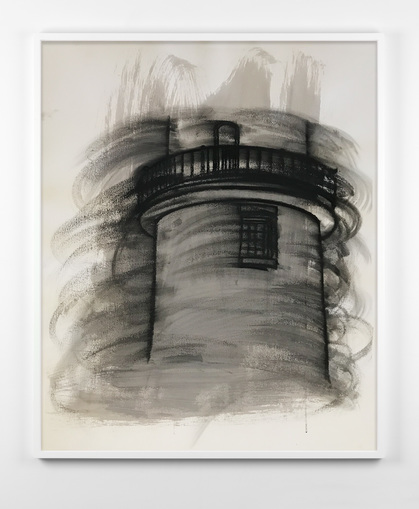-
From Current Issue
-
- Editor’s Letter Fire in the Heart
- Reviews I Gusti Ayu Kadek Murniasih
- Reviews 11th Seoul Mediacity Biennale: “One Escape at a Time”
- Dispatch Networked China
- One on One Monira Al Qadiri on Yukio Mishima
- Essays The rise of independent art spaces in pandemic-era Shanghai
- Features Tuan Andrew Nguyen
- Table of Contents
- Web Exclusives
- Archive
- Subscribe

R
E
V N
E
X
T
Installation view of GARY SIMMONS’s “Dancing in Darkness,” at Simon Lee Gallery, Hong Kong, 2020. All photos by Daniel Murray. All images courtesy Simon Lee Gallery, Hong Kong / New York / London.
Through effaced illustrations of lighthouses and watchtowers, Gary Simmons’s solo exhibition at Hong Kong’s Simon Lee Gallery, “Dancing In Darkness,” explores the plight of being Black in the United States while calling to attention the country’s mass surveillance, most felt in low-income minority neighborhoods.
The African-American artist is known for his erasure style—in which he smudges his drawings—to obfuscate loaded images and reconstruct their meanings. The lighthouse, erected to guide navigators is a metaphor for safety and hope, while the watchtower, an observation point along the peripherals of prisons represents the American criminal justice system. The latter is inextricably linked to the systemic maltreatment of African-Americans who are targets of mass incarceration. This system is a continuation of the country’s long-standing history of racial discrimination, which, following the abolishment of slavery except for criminal punishment, now imprisons Black people at a rate five times higher than that of their White counterparts, with many going into slave labor.
Upon entering a narrow space in the gallery, the viewer is enveloped by five gouache-and-charcoal-on-paper drawings of the two symbolic structures while overlooking the show’s largest painting, an amalgamation of both. Caught between contrasting symbols of sanguinity and despair, viewers are simultaneously confronted with promises of the American Dream, which pledges an attainable security, and the reality of who this dream excludes—marginalized communities in the US face restrictions of basic necessities like underfunded schools.
Untitled (Lighthouse No.5) (2019) portrays the midsection of a lighthouse. Drawn in shrouded black lines, the comforting emblem is transformed into an ominous edifice, suggesting that the protection conventionally associated with this icon is not afforded to all. Similarly, Untitled (Lighthouse No.6) (2019) outlines the top of the building in white charcoal against a translucent layer of gray paint. By separating the structure into individual parts, Simmons further deconstructs notions of safety, propelling the question of whose welfare is truly ensured.
On the wall across were drawings of watchtowers obscured in a similar manner. One of such works, Untitled (Watch Tower No. 4), (2019), depicts the upper section of the tower with downward cameras, highlighting omnipresent surveillance in the US, particularly prevalent in minority concentrated districts in the form of excessive security checkpoints, police presence, and floodlights. Showcasing these works in Hong Kong inevitably forges connections to local censorship and privacy issues, exacerbated by the newly passed National Security Law, which allows the Chinese government to set up its own security force in the Special Administrative Region.
The final piece, Misty Tower Top (2019) blurs the distinction between the two motifs, with the oil-and-wax-on-canvas detailing cameras attached to the body of a lighthouse. Here, the seemingly opposing ideas of hope and oppression are heavily entangled, suggesting that while the US acts as a sanctuary to some, this may be contingent on the suppression of others.
This timely exhibit takes place while the Black Lives Matter movement, ignited by protests of police brutality, is garnering global attention. Staged in Hong Kong, these works allow viewers who may feel removed from this movement to involve themselves in conversations of racial justice, while also connecting the paintings to municipal policies that have direct impact on their own lives.
Eman Naseer is an editorial intern of ArtAsiaPacific.
Gary Simmons’s “Dancing In Darkness” is on view at Simon Lee Gallery, Hong Kong, until August 29, 2020. Please check the exhibition web page for up-to-date information in light of Covid-19.
To read more of ArtAsiaPacific’s articles, visit our Digital Library.

















